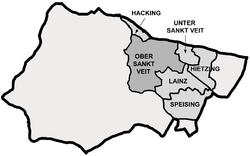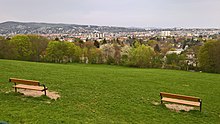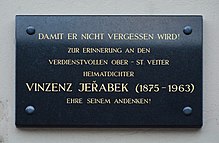Ober Sankt Veit
| Ober-Sankt-Veit | |
|---|---|
| coat of arms | map |
 |

|
Ober-St.-Veit (official spelling of the City of Vienna with hyphens; often without reading them) is a district part of Vienna's 13th district, Hietzing , and one of the 89 Viennese cadastral communities . The historical place, officially mentioned for the first time in 1015, formed the municipality of St. Veit an der Wien from 1850–1870 with Unter-St.-Veit, which emerged in its foreland after 1800, and was then an independent municipality in the crown land of Austria under the Enns until 1890/1892 .
geography
Limits:
- North: Markwardstiege , Erzbischofgasse then south of the Dominican Sisters for Hietzinger Kai - there Wienfluss until after Mantlergasse
- East: Spohrstrasse , Beckgasse , Mühlbachergasse , Nothartgasse , partly Veitingergasse , Wolkersbergenstrasse
- South: between the care home and Hietzing hospital (formerly: Lainz) on the edge of the Hörndlwald to Joseph-Lister-Gasse
- West: Wall of the Lainzer Tiergarten
The small area belonging to the cadastral municipality of Ober St. Veit ( see above !) To the east of the connecting railway, which is bordered by Beckgasse and Mühlbachergasse, is not perceived as part of Ober-St.-Veit today. It is much closer to the town center and the Unter-St.-Veit subway station than their Ober-St.-Veiter counterparts.
history
In 1969 a paleolithic settlement was found in what is today Ober-St.-Veit, which is the oldest trace of human life in Vienna (around 20,000 to 25,000 years old). The first documentary mention is a donation from Emperor Heinrich II. To the Bamberg Cathedral Brothers from 1015. Other names for St. Veit were Godtinesfeld , An der Wien and Auf der Wien . St. Veit suffered under the troops of Matthias Corvinus in the 15th century and was devastated during the first Turkish siege of Vienna in 1529 and the second Turkish siege of Vienna in 1683.
In 1762, Archbishop Cardinal Migazzi sold the castle and estate of St. Vitus to Empress Maria Theresa ; she had the road connection from Schönbrunn laid here, which has been called Hietzinger Hauptstrasse since 1894 and was previously called St. Veit Theresiengasse, later Maria-Theresien-Strasse, on the open field between St. Veit and Alt-Hietzing St. Veiter Gasse or . Street. In 1779 the archbishop bought both back. He and his three successors until 1848 remained landlords until the general abolition of the landlords.
The castle in Ober-St.-Veit was later used as the summer residence of the archbishops. In the vicinity of the castle, agricultural and craft businesses settled. In the beginning, the focus was on viticulture . This became more and more difficult due to regular dry periods and the phylloxera infestation , so that the dairy industry prevailed in the 19th century (more than 150 cows, 2 large dairies : the Glasauer and Wimpissinger families). From then until the year-round residential villas were built, Ober-St.-Veit was a preferred summer retreat near Vienna by the nobility and wealthy citizens.
At the beginning of the 19th century, the archbishop, as landlord, enabled a new settlement between St. Veit and Hietzing: what would later become Unter-St.-Veit . Mainly commercial enterprises and craftsmen settled there. Between the two parts of the community of St. Veit an der Wien , which was founded in 1850, conflicts of interest soon arose, which led the two settlements to seek separation. In 1867, the year of the compromise between Austria and Hungary , the separation was approved by the Lower Austrian provincial government. It then took more than two years before the separation became effective in 1870: Taxpaying companies had argued for a long time over the border between Upper and Lower St. Veit.
On January 1, 1892, both communities were incorporated into Vienna and parts of the 13th district , which was named after the capital Hietzing. The parish hall for St. Veit and Ober-St.-Veit, built in 1857, was located at Hietzinger Hauptstrasse 164 until 1891. The house was demolished around 1970 and replaced in 1992–1994 by an extension to the elementary school.
Around the year of incorporation, the area no longer used for viticulture and agriculture began to be built up, especially with villas, as was previously the case in Hietzing . This made Ober-St.-Veit one of Vienna's posh districts. In 1904, Mayor Karl Lueger applied for a forest and meadow belt on the outskirts of the city. Since 1905 Ober-St.-Veit has been located in a protected green area, which also includes the Himmelhof . From 1897 to 1899 this was the seat of the artist community "Humanitas" of the painter and cultural reformer Karl Wilhelm Diefenbach .
In Ober-St.-Veit, Vienna's Austria (formerly Amateure) had its first stadium of its own near today's underground station. It was opened in 1914, expanded in 1922 and used by Austria until 1931.
From 1945 to 1955 Ober-St.-Veit was in the British sector of Vienna .
Sports
There are two football clubs in Ober St. Veit. On the one hand the ASK Ober St. Veit, on the other hand, the FC Ober St. Veit, which was founded in 2007. Recreational sports are also a popular pastime at Ober St. Veitern due to the large number of offers.
ASK Ober St. Veit
The ASK Ober St. Veit was founded in 1969 by a group of amateur athletes and, after winning the championship in 1st class A, will play in the Oberliga A from 2015. The team plays its games at the ASVÖ 13 sports field.
FC Ober St. Veit
The FC Ober St. Veit was founded in 2007 by a group of amateur athletes and played in the 2012/13 season in the diocesan sports community in the 2nd class A, where they reached 3rd place. The team plays its games in Kendlerstrasse (16th district) at the Red Star Penzing sports field.
traffic
See traffic in Unter-St.-Veit ; the information also includes Ober-St.-Veit. In addition, reference should be made to the Ober St. Veit U-Bahn station and the operation of the district using bus lines 53A, 54B and 54A.
Popular destinations
- Lainzer Tiergarten (already located in the adjacent cadastral municipality of Auhof ); from Ober-St.-Veit the St. Veiter Tor, Hanschweg, leads into the area (the previously open Adolfstor, Adolfstorgasse was closed around 2010)
- Lindwurm Inn, Ghelengasse
- Gasthaus Wildsau, Slatingasse
- Green area Roter Berg , Trazerberggasse, Nothartgasse, Heinz-Nittel-Weg
- old town center with suburban houses and wine taverns , Firmiangasse, Glasauergasse
Interesting structures
- Archbishop's Palace on Wolfrathplatz, aristocratic residence in 1194, donated to the Chapter of St. Stephen by Duke Rudolf IV in 1365 , destroyed by the Turks in 1529 . In the years 1650–1654, a baroque, representative residential palace was built on the order of Prince Bishop Philipp Graf Breuner , the essential elements of which have been preserved unchanged despite some later redesigns. The builder was Domenico Carlone , master stonemason Ambrosius Regondi , judge in the imperial quarry , supplied the main gate and the staircase. The engraving by G. M. Vischer (1672) shows the castle essentially in its present form (only the tower was demolished under Prince Archbishop Sigismund von Kollonitz in 1742). 1762–77 redesign by Nikolaus Pacassi , murals by Johann Baptist Wenzel Bergl , later summer residence of the Archbishop of Vienna until around 1930, today the seat of church schools.
- Baroque church Ober-St.-Veit on Wolfrathplatz, documented in 1365, rebuilt in 1433, destroyed in 1529 and 1683, late Gothic choir, nave 1742; Master builder Matthias Franz Gerl
- Ober-St.-Veiter cemetery , Gemeindeberggasse, with mausoleum ( Egon Schiele's grave )
- U-Bahn station Ober St. Veit , Hietzinger Kai near Franz-Boos-Gasse, architect Otto Wagner
- Art Nouveau house, Schlossberggasse 14, architect Otto Wagner junior
- Faniteum , today the monastery of the Carmelite Order (Sisters), Hanschweg 1
- Dominican nunnery and grammar school , Schlossberggasse
- Villa by Hermann Bahr , architect Joseph Maria Olbrich , in the Winzergasse, corner of Veitlissengasse
Green spaces and parks
See also excursion destinations
- Girzenberg , Flurgasse, Josef-Gangl-Gasse
- Fishing meadow
- Schinaweiss (also Matraswiese)
- Himmelhofwiese, Himmelhofgasse, ski lift, formerly with one of Vienna's ski jumps
- Streckerpark, Auhofstraße / Rohrbacherstraße, built in 1908 in place of the former Ober-St.-Veiter local cemetery
- Franz-Schmidt-Park , Ghelengasse / Prehausergasse, named after the composer
- Goldmarkplatz (especially tennis court and kindergarten)
Mountains and elevations
- Himmelhof 370 m (meadow on the eastern slope of Hagenberg 406 m, which already belongs to KG Auhof )
- Municipality mountain 321 m
- Girzenberg 285 m
- Trazerberg 277 m
- Roter Berg 262 m
Personalities
- Maria Andergast (1912–1995), actress, lived at Schweizertalstrasse 19 during the Second World War.
- Wilhelm Freiherr von Appel (1875–1911), writer and founder of the magazine Die Muskete . On the house at Schweizertalstrasse 16, which was demolished at the beginning of 2017, a memorial plaque unveiled on June 7, 1962 commemorated his stay and place of death.
- Hermann Bahr (1863–1934), writer, had Joseph Maria Olbrich build a house for himself in 1899/1900 at Winzerstraße 22 , which he lived in until 1912.
- Friedrich Julius Bieber (1873–1924), Africa researcher and ethnologist, lived from 1901 at Auhofstrasse 144–144A. (Memorial plaque, unveiled March 20, 1959)
- Ludwig Bowitsch (1818–1881), poet and writer, lived in retirement in Ober St. Veit, where he also died.
- Elias Canetti (1905–1994), writer, lived at Hagenberggasse 47 from 1927 to 1933. (Memorial plaque, unveiled June 30, 1995)
- Miltiades Caridis (1923–1998), conductor, owned the house at Himmelhofgasse 10, built for him in 1968/69 by the architects Friedrich Rollwagen and Kasl Wittmann.
- Robert Demmer (1926–2011), architect, musician, composer and author lived in Josef-Gangl-Gasse.
- Anton Dermota (1910–1989), opera singer, lived at Hagenberggasse 36.
- Karl Wilhelm Diefenbach (1851–1913), painter and cultural reformer, founded the artist community “Humanitas” in 1897 in the house of the former restaurant “Am Himmel” at Himmelhof .
- Karl Forster (1847–1906), manufacturer of physical instruments, chemist, art collector and violinist, had Ferdinand Fellner junior and Hermann Helmer build a summer house with an observatory in Adolfstorgasse 21 in 1889/99 .
- Hans Fraungruber (1863–1933), writer, last lived at Geylinggasse 7.
- Ernst Heinkel (1888–1958), aircraft designer, owned the Villa Blum at Angermayergasse 1 from 1942 to 1950 after the Aryanization in 1941 .
- Karl Jäger (1871–1960), writer, popular educator (director of the Vienna Urania ) and dialect poet lived at Hietzinger Hauptstrasse 162.
- Vinzenz Jeřabek (1875–1963), Viennese homeland poet, was born in the “Spitzerhaus”, Auhofstrasse 120, and died in Ober St. Veiter Castle , which was then used as an old people's home.
- Horst Knapp (1925–1996), business journalist, lived on Trazerberggasse.
- Josef Kraft (1879–1945), archivist and local history researcher, lived at Auhofstrasse 142a.
- Josefine Kramer-Glöckner (1874–1954), actress, bought the house at Winzerstraße 2 in 1902, which she later lived in permanently with her husband Leopold Kramer (1869–1942).
- Erich Lifka (1924–2007), writer, journalist and translator, grew up in Ober St. Veit and lived at Erzbischofgasse 31 until his death.
- György Ligeti (1923–2006), composer, bought the property at Himmelhofgasse 34 with his wife Veronika in 1979 and had the house adapted by Anna-Lülja Praun in 1979/80 and 1987 .
- Erika Mitterer (1906–2001), poet, storyteller and playwright, most recently lived in the Veitingergasse 147 nursing home.
- Fritz Moravec (1922–1997), mountaineer and expedition leader, lived inversorgungheimstrasse.
- George Niemann (1841–1912), architect, building researcher and archaeologist, created the ceiling paintings and frescoes in the house at Einsiedeleigasse 32, bought by his wife in 1887, which they used as a summer home.
- Karl Popper (1902–1994), philosopher and science theorist, was born in Ober-St.-Veit.
- Egon Schiele (1890–1918) had his studio at Hietzinger Hauptstrasse 101 from October 1912 (memorial plaque, unveiled on June 12, 2015), died on October 31, 1918 in Hietzinger Hauptstrasse 114 (memorial plaque) and is on Ober Sankt Veiter cemetery buried.
- Franz Schmidt (1874–1939), composer of late Austrian Romanticism, rector of the State Academy for Music and Performing Arts , lived at Auhofstrasse 145 from 1905 to 1909.
- Sir Rudolf Carl Freiherr von Slatin Pascha (1857–1932), Austrian officer, explorer and Egyptian governor, grew up at 16 Schweizertalstrasse.
- Fritz Stöckl (1912–1989), lawyer and railway writer
- Otto Stoessl (1875–1936), writer, had Adolf Loos build a house for himself in 1911/12 at 20 Matrasgasse (memorial plaque, unveiled October 14, 1981). Stoesslgasse has existed in Unter-St.-Veit since 1955 .
- Georg Strnadt (1909–1980), lived at Premreinergasse 18 from around 1932.
-
William Unger (1837–1932), etcher, engraver and watercolor painter, lived from 1893 to 1919 at Schweizertalstrasse 26.
literature
- Josef Holzapfel: Everyday life in Ober St. Veit . Sutton, Erfurt 2010, ISBN 978-3-86680-602-3 .
- Josef Holzapfel: Historical Ober St. Veit . 1st edition. Interest group merchants Ober St. Veit, Vienna 2009, ISBN 978-3-200-01737-5 .
- Hermann Müller (Ed.): Himmelhof. Original cell of the alternative movement, Vienna 1897–1899 . Umbruch-Verlag, Recklinghausen 2011, ISBN 978-3-93772608-3 .
- Gebhard Klötzl: About mayors and affairs - The Viennese suburbs Ober and Unter St. Veit 1848–1891 . homedia-Verlag, Vienna 2015, ISBN 978-3-200-04246-9 .
Web links
- St. Veit (suburb) in the Vienna History Wiki of the City of Vienna
- Entry on Ober Sankt Veit in the Austria Forum (in the AEIOU Austria Lexicon )
- hietzing.at - Upper St. Veit
- Platform Ober St. Veit
- History of Ober St. Veit
- St. Veit without Vienna and the surrounding areas . Etching, colored, by Johann Andreas Ziegler , 1780. In: bildarchivaustria.at .
Individual evidence
- ^ Felix Czeike : Historisches Lexikon Wien , Volume 6, Kremayr & Scheriau, Vienna 2004, ISBN 3-218-00741-0 , p. 68
- ↑ http://www.1133.at/document/view/id/41
- ↑ http://www.karmel.at/wien-schwestern/
- ↑ http://www.dominikanerinnen.at/
-
↑ Hietzing The 13th district single-family houses 19th century Schweizertalstrasse 19 , accessed on February 26, 2017.
Maria Andergast in the Vienna History Wiki of the City of Vienna -
^ Wilhelm von Appel in the Vienna History Wiki of the City of Vienna
Hedwig Abraham: Schweizertalstraße 16 , Viennatouristguide, accessed on February 27, 2017 - ^ A b Gerhard Hertenberger: Risk of demolition for Schweizertalstrasse 16 in Vienna-Hietzing , accessed on February 26, 2017.
-
↑ Hietzing Der 13th district Villen Villa Bahr , accessed on February 26, 2017.
Villas in Hietzing Villa Bahr , accessed on February 26, 2017.
Josef Holzapfel (hojos): Hermann Bahr , accessed on February 26, 2017. - ^ Friedrich Julius Bieber in the Vienna History Wiki of the City of Vienna
- ↑ Josef Holzapfel (Hojo): Ludwig Bowitsch retrieved on February 26 2017th
-
^ Elias Canetti in the Vienna History Wiki of the City of Vienna Registration sheet for Elias Canetti, Hagenberggasse 47, from May 19, 1927
- ↑ Hietzing The 13th district single-family houses in the 20th century, Himmelhofgasse 10 , accessed on February 26, 2017.
- ↑ a b c d e f Theodor Stöhr, Josef Holzapfel (hojos): Known and unknown , accessed on February 26, 2017.
- ↑ Andrea Harrandt: Demmer, Robert. In: Oesterreichisches Musiklexikon . Online edition, Vienna 2002 ff., ISBN 3-7001-3077-5 ; Print edition: Volume 1, Verlag der Österreichischen Akademie der Wissenschaften, Vienna 2002, ISBN 3-7001-3043-0 .
- ^ Karl Wilhelm Diefenbach in the Vienna History Wiki of the City of Vienna
-
↑ Villas in Hietzing Villa Forster , accessed on February 26, 2017.
Hietzing Der 13th district Villa Forster , accessed on February 26, 2017. - ↑ Adolph Lehmann 's general housing indicator from 1933, Volume 1, 1st part. Residents of Vienna. P. 364 Fous - Frenzl ( 3rd column at the bottom ) , accessed on February 26, 2017.
- ↑ Villas in Hietzing Villa Blum , accessed on February 26, 2017.
- ^ Theodor Stöhr, Josef Holzapfel (hojos): Professor Karl Jäger on the 50th anniversary of his death , accessed on February 26, 2017.
-
↑ Josef Holzapfel (Hojo): Vincent Jerabek from 1875 to 1963. A short biography with materials and text examples , accessed on February 26, 2017.
Vinzenz Jerabek in the Vienna History Wiki of the City of Vienna -
^ Felix Steinwandtner (District Museum Hietzing): Josefine (Pepi) Kramer-Glöckner , accessed on February 26, 2017.
House cadastre of the federal capital Vienna, 12th and 13th district. Compiled on the basis of official data by J. Wolfgang Salzberg, Perles , Vienna 1928. A. XIII. District - IX. Part: Ober-St. Vitus; P. 221 (Josefa Kramer) - ↑ Josef Holzapfel (Hojo): Erich Lifka , accessed on February 26 2017th
- ↑ Hietzing. The 13th district. Detached houses in the 20th century Himmelhofgasse 34 , accessed on February 26, 2017.
- ↑ Erika Mitterer , accessed on February 26, 2017.
- ↑ Josef Holzapfel (Hojo): Prof. Fritz Moravec , accessed on February 28 2017th
- ↑ Villas in Hietzing Villa Niemann , accessed on February 26, 2017.
- ↑ New memorial plaque for Schiele's 125th birthday in Hietzinger Hauptstrasse , APA -ots; June 12, 2015. Retrieved February 28, 2017.
- ↑ Josef Holzapfel (Hojo): The Franz Schmidt Park , accessed on February 26 2017th
-
^ Haus Stoessl , accessed on February 26, 2017;
Josef Holzapfel (hojos): Otto Stoessl , accessed on February 26, 2017;
Otto Stoessl in the Vienna History Wiki of the City of Vienna - ^ Inge Strnadt: Professor Georg Strnadt , accessed on February 28, 2017.
- ^ House cadastre of the federal capital Vienna, 12th and 13th district. Compiled on the basis of official data by J. Wolfgang Salzberg, Perles, Vienna 1928. A. XIII. District - IX. Part: Ober-St. Vitus; P. 218
Coordinates: 48 ° 11 ′ 17 ″ N , 16 ° 15 ′ 59 ″ E




